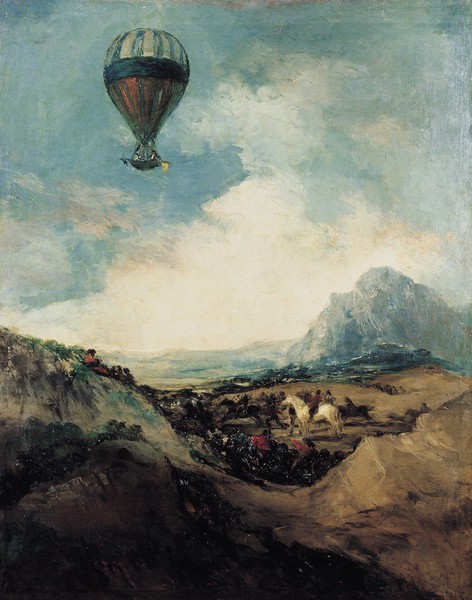- Cronología
- Ca. 1812 - 1816
- Ubicación
- Musée des Beaux-Arts d'Agen, Agen, France
- Dimensiones
- 105 x 84 cm
- Técnica y soporte
- Oil on canvas
- Reconocimiento de la autoría de Goya
- Documented work
- Titular
- Musée des Beaux-arts d' Agen
- Ficha: realización/revisión
- 19 May 2010 / 15 Jun 2023
This work belonged to the collection of Javier Goya before moving to its current location. It appears in the inventory carried out by Brugada following the death of Francisco de Goya. It later went to the Madrazo collection, and from there to the Count of Chaudordy, the French ambassador in Spain, who bequeathed it to the Musée des Beaux-Arts d'Agen in 1899.
A hot air balloon floats across a valley, passing over the top of a number of people on foot and on horseback. According to Camón, the figures were painted quickly, with tiny splashes of colour applied using a spatula, some dashes of red standing out in particular. More than half of the composition is taken up by the sky, which is dominated by the white clouds in the centre of the scene. Below them, the figures rush forwards excitedly.
Goya made some drawings, including the one housed at the Hamburger Kunsthalle (Ca. 1800-1808), which may have served as preparatory studies for the subsequent execution of this painting. We can appreciate some important differences in that drawing if we compare it with this painting. In the drawing, the people are placidly watching the balloon as it moves across the sky, and there is none of the sense of dramatic movement or anxiety that we find in the painting in the French museum.
The subject of hot air balloons was a rather popular one around the end of the 18th century. It is possible that he could have seen the painting by Antonio Carnicero (Salamanca, 1748-Madrid, 1814) entitled The Ascent of a Montgolfier Balloon in Aranjuez (Prado Museum, Madrid). In his work, Carnicero records the 1784 test flight by the French pilot Bouclé, in the gardens of the Spanish royal site. The difference between the painting by Carnicero and that of Goya lies in that the former displays a festive character, reflecting the sense of curiosity and wonder that the new invention of the balloon must have provoked in all those who had gathered to see it. It is a celebration of the technological and scientific innovation of the Enlightenment. In the work by Goya, on the other hand, there is an air of unease, and the people shown in it are not watching the balloon but are instead racing below it, possibly alluding to an episode from the Spanish War of Independence. According to some scholars, it was fairly common during that armed conflict for hot air balloons of this type to be deployed as support elements for troops.
-
GoyaMinistry of Foreing AffairsBurdeos1951organized by the Bordeaux City Hall, consultant editor Gilberte Martin-Méry. From May 16th to June 30th 1951cat. 44
-
Stora Spanska MästareNationalmuseumStockholm1959cat. 151
-
Agen2019cat. 28
-
L'œuvre peint de Goya. 4 volsParís1928-1950p. 289, cat. 268
-
Vie et ouvre de Francisco de GoyaParísOffice du livre1970p. 265, cat. 956
-
BarcelonaPolígrafa1970vol. I, p. 371, cat. 667
-
L’opera pittorica completa di GoyaMilanRizzoli1974cat. 571
-
Le Musée des Beaux-Arts d' AgenParísRéunion des Musées Nationaux2000p. 86, il. 77
-
AgenSnoeck2019p. 131
